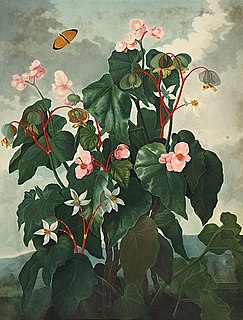
Begonia is a genus of perennial flowering plants in the family Begoniaceae. The genus contains more than 1,800 different plant species. The Begonias are native to moist subtropical and tropical climates. Some species are commonly grown indoors as ornamental houseplants in cooler climates. In cooler climates some species are cultivated outside in summertime for their bright colorful flowers, which have sepals but no petals.

Campsis radicans, the trumpet vine or trumpet creeper, is a species of flowering plant in the family Bignoniaceae, native to the eastern United States, and naturalized elsewhere. Growing to 10 m (33 ft), it is a vigorous, deciduous woody vine, notable for its showy trumpet-shaped flowers. It inhabits woodlands and riverbanks, and is also a popular garden subject.
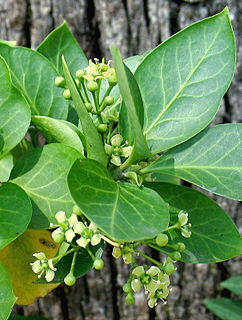
Euonymus fortunei, the spindle, Fortune's spindle, winter creeper or wintercreeper, is a species of flowering plant in the family Celastraceae, native to east Asia, including China, Korea, the Philippines and Japan. It is named after the Scottish botanist and plant explorer Robert Fortune.

Saxifraga stolonifera is a perennial flowering plant known by several common names, including creeping saxifrage, strawberry saxifrage, creeping rockfoil, as well as the quite ambiguous Aaron's beard, mother of thousands, roving sailor, wandering Jew, and strawberry begonia or strawberry geranium.

Begonia grandis, the hardy begonia, is a species of flowering plant in the family Begoniaceae. This herbaceous perennial has alternate, simple leaves on arching stems. The flowers are pink or white, borne in dichotomously branching cymes from late summer through fall in USDA U.S. Hardiness Zone 7. As the common name "hardy begonia" implies, it is winter hardy in some temperate regions.
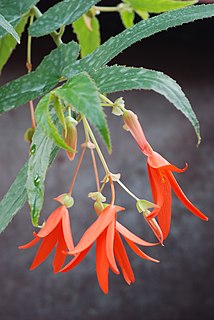
Begonia boliviensis is a plant in the begonia family, Begoniaceae, which was introduced to Europe in 1864 by Richard Pearce who discovered it in the Bolivian Andes, although the plant had previously been identified by Hugh Weddell in the same region but not introduced.

Begonia sutherlandii, known as the Sutherland begonia and as iwozya in Kimalila, Tanzania, is a tuberous flowering perennial plant in the family Begoniaceae, growing to 0.5 metres (20 in) with fleshy pink stems from 10 to 80 centimetres long. Leaves are commonly dark green and veined with red and covered with short hairs on the underside. They are asymmetrical in shape and the margin is toothed. Flowers, produced in pendent panicles throughout summer, are 20–26 millimetres (0.8–1.0 in) in diameter, and are usually orange or orange–red with yellow anthers.
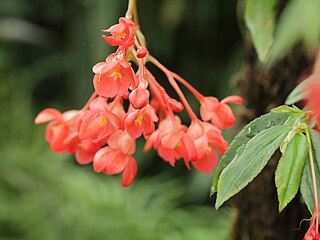
Begonia foliosa is a species of flowering plant in the family Begoniaceae, native to Colombia and Venezuela. It is a shrublike begonia growing to 1 metre (3.3 ft), bearing succulent, pendent stems 45 centimetres (18 in) long, thickly clothed with glossy oval green leaves, and producing panicles of small white flowers. The variety commonly cultivated is B. foliosa var. miniata with pink or red flowers. As it does not tolerate temperatures below 0 °C (32 °F), in temperate regions it requires winter protection.

Begonia listada, the striped begonia, is a species of flowering plant in the family Begoniaceae, native to Brazil. It is a compact shrublike evergreen begonia growing to 0.5 metres (20 in), bearing succulent green leaves with a prominent rib of lighter green, and a reddish underside. It produces small pink-tinted white flowers intermittently throughout the year. As it does not tolerate temperatures below 10 °C (50 °F), in temperate regions it must be grown under glass.
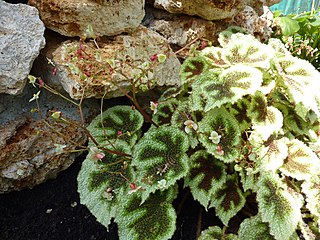
Begonia masoniana, the iron cross begonia, is a species of plant in the family Begoniaceae, native to southern China and northern Vietnam. It was originally described from cultivated plants of unknown origin and was only much later rediscovered in the wild. It is a rhizomatous perennial begonia growing to 0.5 metres (20 in), bearing large, asymmetrical, textured green leaves covered in reddish hairs, with a prominent dark brown pattern in the centre of each leaf, reminiscent of the German Iron Cross. It produces small white flowers in erect panicles, but is cultivated mainly for its foliage effect. In temperate regions it must be grown under glass, or in a completely frost-free environment. Although sometimes (incorrectly) considered a rex begonia, this species is classified in the related section Coelocentrum.
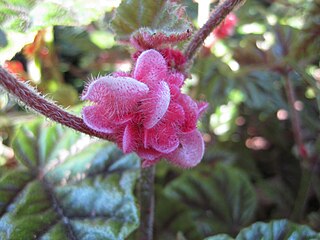
Begonia incarnata is a species of plant in the family Begoniaceae, native to Brazil. It is a shrublike evergreen perennial growing to 1 metre (39 in), bearing large, asymmetrical green leaves with a metallic sheen, and dark green veins. It produces small hairy pink flowers. As it does not tolerate temperatures below 10 °C (50 °F), in temperate regions it must be grown under glass.

Woodwardia radicans, the chain fern, European chain fern or rooting chainfern, is a species of fern in the family Blechnaceae, native to the Atlantic islands and southwestern Europe. Growing to 1.8 m (6 ft) tall by 2 m (7 ft) broad, it is evergreen with arching fronds. The pinnae have curved, finely-toothed segments. The plant derives its common name from the linked sori on the undersides of the fronds.
Charlotte Milliken Hoak (1874-1967) was a 20th-century teacher, horticulturist, occasional botanist and garden columnist in Southern California. She advocated the use of native plants for landscaping public places including roadsides because they were best suited for the environment and did not draw on scarce water resources. As a teacher she taught organic gardening and composting techniques to her elementary school students and members of the community. Charlotte received recognition and awards from several plant societies, garden clubs, and well known botanists and horticulturists with whom she worked. Her contributions to the field of horticulture and her advocacy for the conservation of natural resources and preservation of wild-lands is documented and warrants recognition.
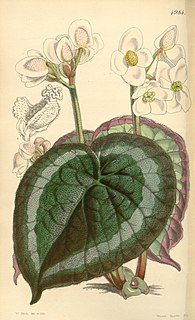
Begonia annulata, the ringed begonia, is a species of flowering plant in the genus Begonia native to the eastern Himalaya, Bangladesh, Assam in India, Myanmar, and Vietnam. It has gained the Royal Horticultural Society's Award of Garden Merit.

Begonia carolineifolia, the palm leaf begonia, palmate begonia or hand begonia, is a species of flowering plant in the genus Begonia native to central and southern Mexico and northern Central America. It has gained the Royal Horticultural Society's Award of Garden Merit.
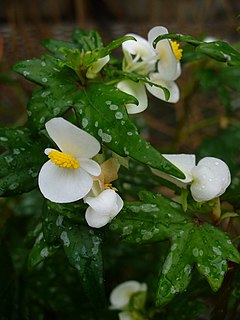
Begonia dregei, the maple leaf begonia or grape-leaf begonia, is a species of flowering plant in the genus Begonia native to South Africa. It has gained the Royal Horticultural Society's Award of Garden Merit.

Begonia imperialis, the imperial begonia, is a species of flowering plant in the genus Begonia, native to southern Mexico and Guatemala. It has gained the Royal Horticultural Society's Award of Garden Merit.

Begonia luxurians, the palm leaf begonia, is a species of flowering plant in the genus Begonia, native to southeastern Brazil. It has gained the Royal Horticultural Society's Award of Garden Merit.
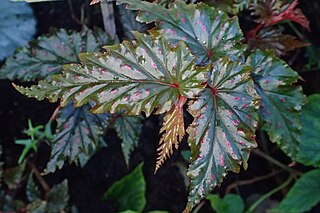
Begonia serratipetala is a species of flowering plant in the genus Begonia, native to New Guinea. It has gained the Royal Horticultural Society's Award of Garden Merit.
Begonia solananthera, the Brazilian heart begonia, is a species of flowering plant in the genus Begonia, native to southeastern Brazil. It has gained the Royal Horticultural Society's Award of Garden Merit.


















